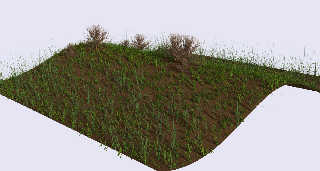|
 |
Hi,
I'm pretty new to POV (Well, I did mess some with it about 5 years ago (You
know the standard RSOCP's and so on =))) and a first time poster on the
forums, and have been playing around with POV a month or so and love it.
I got so impressed with Norbert Kern's Vegetation Simulation WIP's so I
thought I had to have a go at it (as I a long time have had a plan to make
some artificial life simulator with a (simple) ecosystem and this was a
first simple step in that direction). So this Sunday i sat down and wrote a
simple program in C++ that does a simulation with 8 species with different
water requirements, growth rates, maximum size and so on. And then added a
export capability that wrote a povray include file with the plants as
objects with size and position and a randomized rotation (to get some
variation within a species as i use the same mesh for all the plants within
a species).
Yesterday night I sat down a hour or so and made these extremly simple
plants only using Gilles Tran's lovely Makegrass macro, and a shrub/tree
just exported from Arbaro, and then let my computer chew on it overnight.
This is the result of this, and I'm pretty pleased with the result, although
it would be nicer if I had more variation on the plants, but this will come
with time.
I will, if I have the time, make the software more user friendly (as it is
now one has to change the source code to change anyting in the program),
and more advanced. And if there is an intrest make it available as a open
source program if it gets good enough and there is a intrest, but no
promises that it will ever get to that point =)...
Some facts about the image:
The simulation in my program took about 1 minute which created 4342 plants,
the parsing time was 16 sec and it rendered in 1h 21m, peak memory used
236MB.. The computer is a Athlon XP 2500+ with 512MB memory..
In the image you can se the species differentiated by colour and height (the
blueish green high plants are water loving, and the darker green really
short
tufts are dry loving, the other species are in between these in size and
colour (and in preference for soil conditions). The surface is just a simple
cosine function in the z direction and the wetness depends on the height of
the surface (low -> wet, high -> dry).
And I would like to thank Norbert Kern for giving a pointer in the right
direction with the link to the article in his post, and his incredible and
inspiring images. And of course all other here in the forums, I hope I can
become just half as good as some of you guys =)..
All c&c is welcome, and tips on improving the image, hope you like it...
/Jani
Post a reply to this message
Attachments:
Download 'vegetationtest.jpg' (496 KB)
Preview of image 'vegetationtest.jpg'

|
 |




![]()